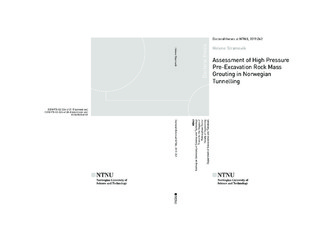| dc.contributor.advisor | Grøv, Eivind | |
| dc.contributor.advisor | Nilsen, Bjørn | |
| dc.contributor.advisor | Håkansson, Ulf | |
| dc.contributor.author | Strømsvik, Helene | |
| dc.date.accessioned | 2020-03-02T14:07:02Z | |
| dc.date.available | 2020-03-02T14:07:02Z | |
| dc.date.issued | 2019 | |
| dc.identifier.isbn | 978-82-326-4120-8 | |
| dc.identifier.issn | 1503-8181 | |
| dc.identifier.uri | http://hdl.handle.net/11250/2644729 | |
| dc.description.abstract | Due to growth of the population in cities and limited space there is an increasing trend to move transportation systems, such as roads and railroads underground. Furthermore, Norway is a rugged country with deep fjords, high mountains and numerous islands, where tunneling is an essential measure to ensure effective transportation connecting the different parts of the country.
If no measures are performed to reduce water inflow into tunnels, they will work as very efficient drains of the groundwater. Lowering of the groundwater table has many adverse consequences, such as damage on infrastructure and buildings due to ground surface settlement, drainage of lakes and desiccation of vegetation. High ingress of water into a tunnel can also be unfavourable for the work during construction and water seepage in tunnels under operation could lead to corrosion of installations, slippery roads or formation of icicles during the winter. For these reasons, tunnels have different requirements regarding allowable water inflow, depending on the use and location.
The most common method for reducing groundwater ingress into tunnels in Norwegian tunnelling, is cement grouting ahead of the tunnel work face, termed pre-grouting (short for pre-excavation grouting). In Norwegian rock mass pre-grouting practice the grouting pressure is significantly higher than in other countries worldwide. The use of high pressure originates from decades of practical experience in grouting of rock caverns, subsea tunnels and hydropower projects. Furthermore, the grouting pressure was slightly increased and standardised by the research project “Tunnels for the citizens” (finished in 2004), but there is little research to justify the usage of high pressure. Despite a wide empirical basis there are unresolved questions related to the use of high grouting pressure.
True Improvement in Grouting High pressure Technology for tunnelling (TIGHT) is a competence building project (KPN) in user defined innovation arena (BIA), carried out in the period of 2014 to 2018. This PhD is written in connection with TIGHT. The main goal of the project was to increase the understanding of rock mass grouting to such extent that it would lead to a significant differentiation on use of materials and pressure pending on the actual circumstances for any given project.
The fundamental objective for this PhD is to achieve an increased understanding of rock mass grouting with the use of high grouting pressures and to investigate if the current practice of using high grouting pressure is optimal regarding reduction of water inflow in tunnels, in line with good economy and caretaking environmental aspects. The thesis is comprised of two different methods to investigate pre-grouting: analysis of data from the grouting process and investigation and assessment of pre-grouted rock mass.
The principal conclusions based on this PhD study are that pre-grouting with the use of high grouting pressure in general is successful regarding the reduction of water ingress into tunnels. When it comes to economy and environmental aspects there is potential for improvement. The study showed a high prevalence of hydraulic jacking of fractures during pre-grouting and the grout and time consumption in holes where hydraulic jacking was indicated in general were considerably increased. It is concluded that by adjusting the grouting strategy after the occurrence of hydraulic jacking, the grout consumption could be decreased without inflicting negatively on the reduction of water ingress into the tunnel.
The thesis highlights the importance of understanding how cement based grout spreads in rock mass fractures with different grouting strategies, types of grout and grouting pressure. Furthermore, it discusses how to perform successful pre-grouting with respect to the reduction of water inflow into tunnels, economy and environmental aspects. | |
| dc.language.iso | eng | nb_NO |
| dc.publisher | NTNU | nb_NO |
| dc.relation.ispartofseries | Doctoral theses at NTNU;2019:262 | |
| dc.relation.haspart | Paper 1:
Strømsvik, Helene; Morud, John; Grøv, Eivind.
Development of an algorithm to detect hydraulic jacking in high pressure rock mass grouting and introduction of the PF index. Tunnelling and Underground Space Technology 2018 ;Volum 81. s. 16-25
https://doi.org/10.1016/j.tust.2018.06.027 | |
| dc.relation.haspart | Paper 2:
Strømsvik, Helene.
The significance of hydraulic jacking for grout consumption during high pressure pre-grouting in Norwegian tunnelling. Tunnelling and Underground Space Technology 2019 ;Volum 90. s. 357-368
https://doi.org/10.1016/j.tust.2019.05.014
This is an open access article under the CC BY-NC-ND license
(http://creativecommons.org/licenses/BY-NC-ND/4.0/). | |
| dc.relation.haspart | Paper 3:
Strømsvik, Helene; Gammelsæter, Bjørnar.
Investigation and assessment of pre-grouted rock mass.
The final published version is available in Bulletin of Engineering Geology and the Environment 2020 ;Volum 79.(5) s. 2543-2560
https://doi.org/10.1007/s10064-019-01722-9
This article is licensed under a Creative Commons
Attribution 4.0 International License (CC BY 4.0)
https://creativecommons.org/licenses/by/4.0/ | |
| dc.title | Assessment of High Pressure Pre-Excavation Rock Mass Grouting in Norwegian Tunneling | nb_NO |
| dc.type | Doctoral thesis | nb_NO |
| dc.subject.nsi | VDP::Technology: 500::Rock and petroleum disciplines: 510 | nb_NO |
| dc.description.localcode | digital fulltext is not avialable | nb_NO |
